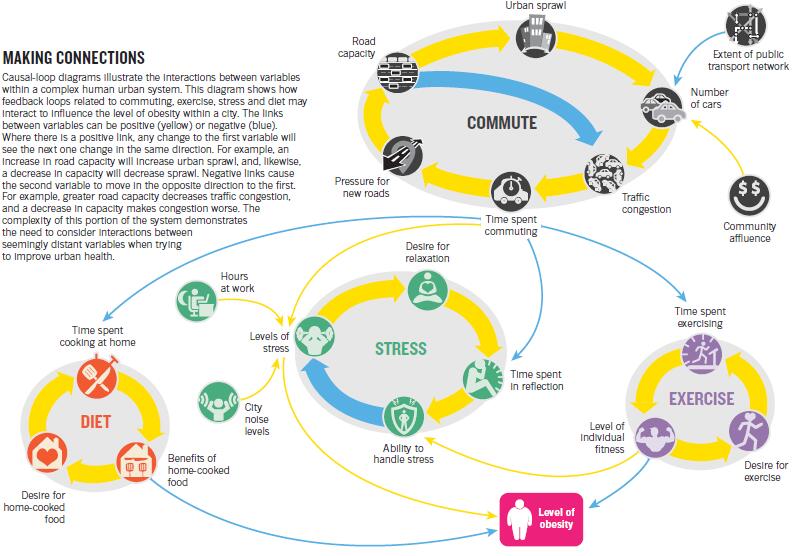[要闻] 科学前沿要闻-012 2016-4-26
[ NATURE | OUTLOOK ] Policy: Urban physics
Kevin Pollock,Nature 531, S64–S66 (17 March 2016) doi:10.1038/531S64a,Published online 16 March 2016
政策:城市物理学
这篇文章主要的思想是:从物理学中借鉴了一种方法去管理城市——这种社会网络。大致思路是:首先交代了,将城市作为复杂系统研究,这种思想来源于物理,又在系统的层面上构建了模型,可以改变条件,预测造成的影响(并没有说明模型的具体情形);城市是不断演化的,而且在城市规划中,为解决某些问题而出台政策,同时又不会带来新的问题,这本身是比较困难的;文章还介绍了环形思维;最后强调了要从系统的角度解决城市规划、政策制定等问题,并用多个学科的角度研究事物,跨学科去探索。
The ideal city. That was what the French had in mind when they made Hanoi the capital of colonial Indochina at the turn of the twentieth century. To modernize the tropical city, French administrators, technocrats and engineers built railways, bridges and an opera house. But rather than becoming a symbol of success in their southeast Asian colonial project, Hanoi became an example of urban apartheid. The European quarter was renovated with wide, tree-lined avenues, and large, spacious villas. Whereas the old quarter, home to the native Indochinese, was a place of narrow roads and overcrowded buildings.
This pattern has recurred throughout the history of modern cities, as urban policies and interventions perpetually yield unpredicted, and sometimes dire, consequences. This is typical of a network as physically and socially complex as a city. Implementing policies to fix what’s broken without introducing a new set of problems is in many ways the central challenge of urban improvement. A way of thinking borrowed from theoretical physics may be the best chance that urban planners have of overcoming it.
COMPLEX MODELS
Cities are complicated. They comprise large numbers of people, and the many ecological, cultural, social and economic entities that make up their environment. All these factors interact in time and space to form complex systems that constantly evolve in response to changes in climate, environment and people.
The characterization of cities as complex systems is based on work that originated in an entirely different field. Physicist and Nobel laureate Philip W. Anderson proposed complexity theory in his 1972 article ‘More Is Different’ in an effort to understand the “shift from quantitative to qualitative differentiation” in his discipline of many-body physics (P. W. Anderson Science 177, 393–396; 1972). The behaviour of complex aggregates of elementary particles such as the atomic nucleus could not be understood solely in terms of the properties of their individual components. Instead, Anderson reasoned, at each level of complexity entirely new properties appear, and each level of understanding requires a new conceptual structure. An atom in isolation can be thought of as “a featureless, symmetrical little ball”, he wrote, but the presence of other particles and environmental conditions changes the shape and reactivity of that atom. Failure to take these changes into account renders the understanding of any measurable observations difficult, if not impossible.
The same is true of cities. As one expands from the perspective of an individual urban dweller to the neighbourhood or town level, new interactions emerge and the complexity of the network increases. Since its inception, Anderson’s theory of complex systems has spread beyond particle physics to a variety of other disciplines, including biology and economics.
By analysing as much data about cities as possible — everything from crime statistics to efficiency of public transport — Bettencourt and his colleagues have been able to identify key variables and interactions to formulate a picture of an urban system. These models have allowed the team to demonstrate that many of the factors affecting urban well-being are tied, in remarkably predictable ways, to the size of a city; as population grows, so too does crime, for instance. Modelling is also useful in understanding how well-meant health interventions in cities can have unforeseen effects. Although models of complex urban systems can’t provide planners with specific policies to enact to improve health and well-being, they can help to explain one of the trickiest properties of complex systems: feedback.
LOOPED THINKING
Complex systems such as cities are alive with feedback loops. The effects of an intervention in one area can produce changes in another, which can, in turn, either amplify or oppose the original intervention. The simplest example of a feedback loop is a thermostat: as the temperature drops below the target level, the heating clicks into life and warms up the room. The increased temperature then feeds back, and the heating is switched off.
In the case of the thermostat, the loop is by design. But in cities, unexpected loops abound. Once again, Hanoi provides a classic example. Faced with the rat problem, in 1902 French colonialists began to pay rat catchers to reduce the population. Wages were dependent on the number of severed tails presented to the authorities. But the rodent bounty did not work as planned — some made the most of the financial opportunity and began breeding rats for their tails.
Feedback loops can also be seen in cities that expand their road networks to tackle traffic congestion. Although the additional road capacity does initially reduce congestion, over time the effect is usually to entice more people to drive, and consequently to bring about more traffic jams, a higher risk of accidents and increased vehicle emissions. Such a loop cannot be described in isolation, however. The effects of the intervention can be seen elsewhere. Where roads are built can affect decisions about housing and energy, and the time spent commuting in traffic can reduce the time spent exercising, increasing the level of obesity (see ‘Making connections’).
As is the case with any public expenditure, most would agree that urban policy should ideally be evidence based. But with seemingly endless loops of cause and effect to negotiate, determining whether an urban policy has been a success or not can be tricky.
There are many different methods used by the public, private and social sectors of society to evaluate policy impact “which must be adapted to each specific case and each specific problem,” says Ernesto Amaral, a sociologist at the RAND Corporation in Santa Monica, California. When measuring the impact of a policy, he says, the ideal scenario is to compare a group that receives the policy with a ‘control’ group that doesn’t. It is a simple enough concept, but as the Hanoi-sewer story illustrates, even in cases in which a control group is available, policies do not have binary outcomes — a single policy can have multiple effects, good and bad.
Another problem is how to demonstrate that a policy works when the outcomes might take decades or longer to appear. There can be multiple outcomes and the policymakers responsible for the initial intervention may have moved on by the time those outcomes occur. “It gets complicated to correlate back to the specific actions that actually caused them,” says Barry Newell, a systems dynamicist at the United Nations University International Institute for Global Health (UNU–IIGH) in Kuala Lumpur, Malaysia.
Overcoming the silos into which different aspects of the city network are divided — water, transport, health and so on — is a central challenge of urban planning. In a system as complex as a city, no one person or speciality can see the whole picture; urban health is an interdisciplinary problem that requires collaboration across administrative and scientific barriers. Once again, Anderson’s theory of complexity makes the way ahead clear. Rather than have each discipline focus on making inroads into problems by themselves, Anderson wrote, “we should recognize that such roads, while often the quickest shortcut to another part of our own science, are not visible from the viewpoint of one science alone.”
Threats to urban health and well-being span disciplinary boundaries, and systems thinking offers a tool by which these boundaries can be bridged, says Gatzweiler “We need systems thinking and the co-production of knowledge in order to create healthier, wealthier cities, and people within them.”

Causal-loop diagrams illustrate the interactions between variables within a complex human urban system. This diagram shows how feedback loops related to commuting, exercise, stress and diet may interact to inuence the level of obesity within a city. The links between variables can be positive (yellow) or negative (blue). Where there is a positive link, any change to the ‑rst variable will see the next one change in the same direction. For example, an increase in road capacity will increase urban sprawl, and, likewise, a decrease in capacity will decrease sprawl. Negative links cause the second variable to move in the opposite direction to the ‑rst. For example, greater road capacity decreases trac congestion, and a decrease in capacity makes congestion worse. The complexity of this portion of the system demonstrates the need to consider interactions between seemingly distant variables when trying to improve urban health.
原文链接:http://www.nature.com/nature/journal/v531/n7594_supp/full/531S64a.html



